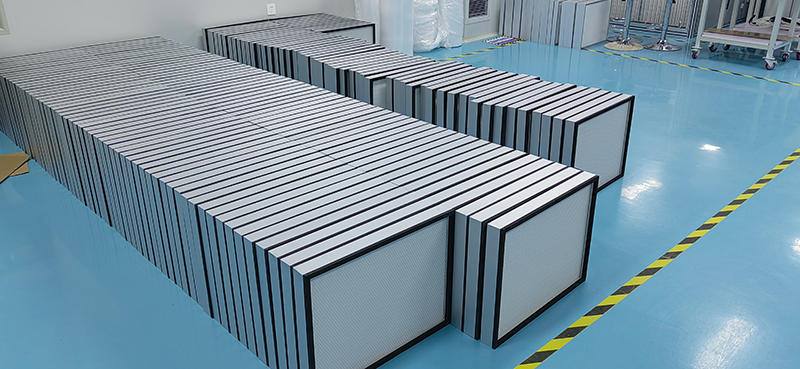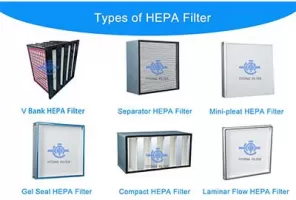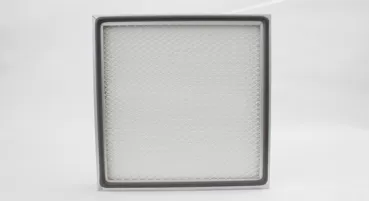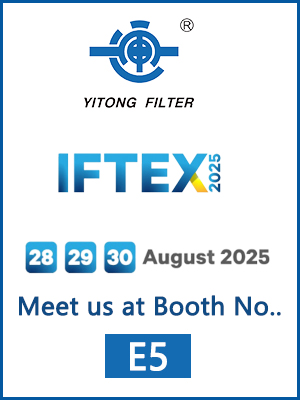 September 05, 2025
September 05, 2025
Air quality has a direct impact on human health, product safety, and the reliability of industrial processes. In many industries—such as pharmaceuticals, healthcare, biotechnology, electronics, and aerospace—the air must be kept extremely clean to avoid contamination. Even microscopic particles can lead to product defects, research failures, or serious health risks.

This is where H14 filters play a vital role. As one of the highest grades of HEPA filters, H14 filters are designed to capture 99.995% of airborne particles as small as 0.3 microns. They are trusted in some of the most demanding environments in the world, from hospital operating rooms to semiconductor cleanrooms.
In this article, we will explore what H14 filters are, how they work, and why they are indispensable for industries that demand absolute cleanliness. We’ll also look at their benefits, industry applications, regulatory requirements, and future trends.
An H14 filter is a high-efficiency particulate air (HEPA) filter classified under the EN 1822 standard. The “H” stands for HEPA, while the number indicates the filter class.
Efficiency requirement: An H14 filter must capture 99.995% of particles at the Most Penetrating Particle Size (MPPS).
Particle size: This typically includes particles as small as 0.1–0.3 microns, which are the most difficult to filter.
Classification:
H11 filters: 95% efficiency
H13 filters: 99.95% efficiency
H14 filters: 99.995% efficiency
In short, H14 filters sit at the top of the HEPA range, just below ULPA (Ultra Low Penetration Air) filters, which achieve even higher efficiency but with increased airflow resistance.
Unlike simple mesh or sieve filters, H14 filters use a complex filtration mechanism to trap particles:
1. Interception – Particles following the airflow path come into contact with filter fibers and stick to them.
2. Impaction – Larger particles cannot follow the airflow streamlines and collide directly with the fibers.
3. Diffusion – Very small particles move erratically (Brownian motion) and are eventually captured by fibers.
This three-way mechanism ensures that particles of all sizes are effectively removed, including bacteria, mold spores, dust, and even viruses.
Filter Media: Usually made of fine glass microfibers or synthetic fibers.
Frame Materials: Aluminum, galvanized steel, MDF (medium-density fiberboard), or stainless steel.
Seals and Gaskets: Ensure no air bypasses the filter, which is critical in cleanroom and healthcare environments.
By design, H14 filters maintain a balance between airflow resistance and filtration efficiency, making them suitable for high-performance HVAC and air handling systems.
1. Ultra-High Filtration Efficiency
Captures 99.995% of airborne particles, including bacteria and viruses, ensuring the cleanest possible air.
2. Enhanced Safety and Health Protection
Reduces the risk of airborne infections in healthcare facilities and contamination in manufacturing processes.
3. Compliance with Strict Regulations
Meets EN 1822 and ISO 29463 standards, as well as FDA and GMP requirements in pharmaceutical production.
4. Protects Sensitive Processes
Ensures product integrity in industries where even the smallest contaminants can cause failures.
5. Supports Worker Safety
Provides a healthier working environment for staff in cleanrooms, labs, and hospitals.
1. Pharmaceutical Manufacturing
The pharmaceutical industry demands extremely high levels of cleanliness. Contaminated air can compromise drug safety, reduce effectiveness, and even cause regulatory violations.
Cleanrooms: H14 filters are installed in air handling units and laminar flow cabinets to maintain ISO Class 5 or better cleanroom conditions.
Sterile Production: Used in sterile filling lines for vaccines, injectables, and biologics.
Regulatory Compliance: Essential for meeting GMP (Good Manufacturing Practice) standards.
Example: During vaccine production, H14 filters prevent airborne microbes and particles from contaminating the sterile environment.
2. Healthcare and Hospitals
Airborne infections are a major concern in hospitals. H14 filters are used in:
Operating Rooms – Prevent surgical site infections.
Intensive Care Units (ICUs) – Protect vulnerable patients from airborne pathogens.
Isolation Wards – Contain contagious diseases such as tuberculosis or COVID-19.
By capturing viruses and bacteria, H14 filters play a critical role in hospital infection control strategies.
3. Electronics and Semiconductor Industry
In semiconductor fabrication, a single speck of dust can ruin an entire wafer. H14 filters are used to ensure particle-free environments in:
Wafer manufacturing cleanrooms
Microchip assembly areas
Optical device production
They help maintain ISO Class 5 or better cleanroom standards, where air purity is measured in particles per cubic meter.
4. HVAC Systems in Critical Buildings
H14 filters are integrated into Air Handling Units (AHUs) in sensitive facilities such as laboratories, pharmaceutical plants, and data centers.
They balance energy efficiency with air quality performance.
Advanced designs allow lower pressure drops to reduce energy consumption while maintaining high filtration levels.
5. Biotechnology and Research Laboratories
In biotechnology labs, preventing cross-contamination is crucial. H14 filters are used in:
Biological Safety Cabinets (BSCs)
Biosafety Laboratories (BSL-2 and BSL-3)
Genetic and molecular research facilities
These filters ensure experiments remain uncontaminated, protecting both the research and the researchers.
6. Food and Beverage Processing
Airborne microbes can spoil food, shorten shelf life, and create safety risks. H14 filters are used in:
Packaging areas
Fermentation processes
Dairy and beverage bottling facilities
They help food processors comply with hygiene standards and extend product safety.
H13 vs. H14:
H13: 99.95% efficiency
H14: 99.995% efficiency
For pharmaceutical and hospital applications, H14 is preferred.
H14 vs. ULPA:
ULPA filters: 99.99995% efficiency, but higher airflow resistance.
H14 offers the best balance between efficiency and energy consumption.
Proper installation and maintenance are essential for H14 filter performance:
Installation: Ensure airtight seals; even small leaks compromise performance.
Monitoring: Regularly measure pressure drop to track clogging.
Replacement: Follow manufacturer schedules; frequency depends on usage and environment.
Safety: Replace with protective equipment to avoid exposure to trapped contaminants.
EN 1822 (Europe) – Defines HEPA and ULPA filter classes.
ISO 29463 (International) – Similar to EN 1822, used globally.
FDA & GMP Guidelines (Pharma) – Require validated air cleanliness levels.
WHO & CDC (Healthcare) – Recommend HEPA H14 filters for infection control.
ISO Cleanroom Standards – ISO Class 5, 6, or 7 require high-performance filters like H14.
1. Post-COVID Demand: Increased awareness of airborne pathogens has boosted demand for H14 filters in hospitals and public spaces.
2. Energy Efficiency: Research is ongoing to reduce pressure drops without sacrificing filtration efficiency.
3. Smart Filters: Integration with digital monitoring systems to track real-time performance.
4. Sustainability: Development of recyclable filter media and eco-friendly manufacturing processes.
Q1: What particle size does an H14 filter capture?
It captures 99.995% of particles at the Most Penetrating Particle Size (MPPS), typically 0.1–0.3 microns.
Q2: Are H14 filters effective against viruses such as COVID-19?
Yes, H14 filters capture particles in the size range of many viruses, including coronavirus, when integrated properly in HVAC or cleanroom systems.
Q3: How often should H14 filters be replaced?
Replacement schedules vary but typically range from 6 months to 2 years depending on usage and contamination load.
Q4: Can H14 filters be used in residential systems?
While technically possible, they are usually over-specified for homes due to high resistance and cost.
Q5: What is the difference between H14 and ULPA filters?
ULPA filters are more efficient (99.99995%) but create higher pressure drops. H14 filters strike a balance between efficiency and energy efficiency.
The H14 filter is one of the most advanced and reliable filtration solutions available today. With 99.995% efficiency, it ensures ultra-clean air in environments where contamination control is critical—whether in pharmaceutical production, hospitals, electronics manufacturing, cleanrooms, or biotech research.
By providing unmatched protection for people, products, and processes, H14 filters have become a cornerstone of modern industry standards. As demand for cleaner air continues to rise, H14 filters will remain essential in ensuring safety, compliance, and operational success.
 Nov. 20, 2023
The Application of Air Filters in Cleanrooms
Nov. 20, 2023
The Application of Air Filters in Cleanrooms
 Aug. 15, 2024
Approved vs. Standard HEPA Filter Types: Making the Right Choice
Aug. 15, 2024
Approved vs. Standard HEPA Filter Types: Making the Right Choice
 Jan. 02, 2024
Performance indicators and inspection methods of HEPA filters
Jan. 02, 2024
Performance indicators and inspection methods of HEPA filters

